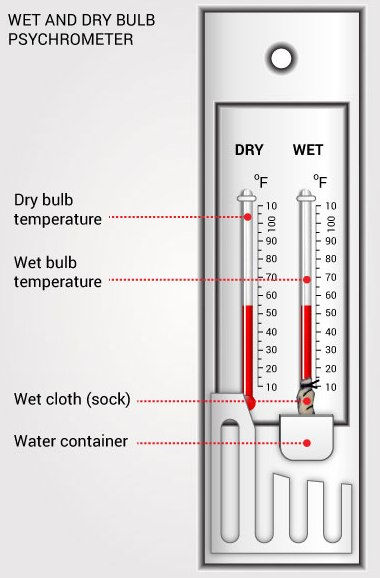- Show results for
- Share
Why and How to Use Psychrometers
Resource Description

When water vaporizes, it cools whatever surface it was on. For example, sweat cools your body as it vaporizes. The air, however, can only contain a certain quantity of water. When it is humid, the air is saturated with as much water as it can contain, and water does not vaporize easily.
Humidity is measured by a special type of hygrometer that is called a psychrometer. Knowing the construction and function of the psychrometer, you will totally get precise measurements of the humidity.
What Is Psychrometer And Its Function
A traditional psychrometer is a type of hygrometer that is used exclusively to determine the relative humidity or moisture content in the air. Traditional psychrometers represent an older humidity measurement form, and electronic sensors that depend on changes in electrical resistance and capacitance rather than condensation temperature have widely replaced them.
*Note: Hygrometers and psychrometers are not similar at first sight. Find out what is the difference between the devices here.
However, psychrometers are still found in many industrial environments and are available in both stationary and mobile versions. It is a useful instrument to keep in the house. It measures the quantity of water vapor in the air or relative humidity.
Relative humidity refers to the moisture content in the air compared to how much moisture the air can grasp at a given temperature. Information about relative humidity is important in understanding the weather. A psychrometer is an instrument that counts both the wet-bulb and dry-bulb temperatures. Two thermometers are required to count these constraints. From the values obtained, the relative humidity can be known.
Knowing the relative humidity helps understand the weather and what to expect. It is also helpful if you keep several indoor plants.
Psychrometers' Construction And Charts

The instrument consists of a dry-bulb and wet-bulb thermometer. The dry-bulb measures temperature. It is left as it is, without any covering, for maximum exposure to air. The wet bulb must be kept wet. It is covered with some wet cloth or sock or dipped in water until it is required for use. At the desired time, you remove the wet bulb from the water but retain the wet cloth (sock) on it.
Readings of both bulbs are taken immediately and also at intervals of a few minutes. The note is made of the cooling temperatures on the wet bulb. The temperature of the wet bulb will always be lower than the dry-bulb due to the evaporating water, which creates a cooling effect. A comparison of the two temperatures gives you the relative humidity of the air.
Obtaining exact relative humidity and dew-point from a psychrometer requires calculations that can get time-consuming without the use of the software. The easiest route to glean this information is through the use of psychrometric charts.
Psychrometric charts help scientists to explore the intersection of the dry and wet bulb temperatures from the device to observe the air’s thermal features. Psychrometric charts include such information:
- Relative humidity - helps to observe how close the air is to the desirable humidity;
- Dew point - allows to look up the temperatures at which the moisture that is in the air will begin to condense;
- Enthalpy - shows the amount of heat the air contains in units BTU per pound units of dry air;
- Humidity ratio - shows pound of moisture in the air per pound of dry air;
- Specific volume - determines the amount of space the fair catches.
Types Of The Psychrometers
Psychrometers measure the humidity in the general environment or specific areas (such as a chamber or structure). Psychrometers are generally used in laboratory settings to determine precise measurements for experiments and chemical reactions.
.jpg)
A stationary psychrometer is the most common and is used in some forms of industrial equipment, while a mobile psychrometer, known as a sling psychrometer, consists of two thermometers attached to a handle and is spun in the air for several minutes to calculate the relative humidity in the field.
.jpg)
Compared to a sling psychrometer, a digital psychrometer is remarkably easy-to-use. There's no need to wave the psychrometer around for several minutes before you can make your calculations. It's all automatic at the push of a button. For those who need to use a psychrometer, this takes all the effort out of the task and makes the process a great deal faster.
You can obtain more data and perform more calculations with a digital psychrometer. At the push of a button, you'll be able to find the percentage of relative humidity in the air, as well as the dew-point and the temperature, including the wet-bulb temperature. The difference between the two temperatures (dry-bulb and wet-bulb) can be calculated very easily. A good digital psychrometer will let you store data, including maximum and minimum readings, which allows you to make ongoing comparisons. For different areas, you'll also be able to switch simply between measurements in °C and °F.
Where Is Psychrometer Used
Even though psychrometers are seldom used nowadays. However, they are still used to calibrate humidistats, which are used to control the inner humidity of the air conditions and heating systems of the industrial buildings. Previously, psychrometers helped with the design of ventilation systems.
Psychrometers are also used by scientists in their different science disciplines. Nowadays, students of the science departments learn how to use this device and interpret psychrometric charts. Meteorologists and environmentalists measure atmospheric conditions by the psychrometer. Agricultural engineers, who design spaces with specific humidity requirements like greenhouses and barns for livestock, also need this device, to provide comfortable conditions for the applications.






